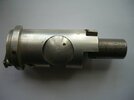The first German influence mine dropped by aircraft (German nomencleature unknown) was recovered on 23 November 1939 at Shoeburyness and had a bomb fuze 24A type. The British nomenclature was GA. After that a GA* mine was recovered (German nomenclatures unknown) that had also a 24A bomb fuze. The following one was a GB mine (German nomenclature unknown) with a 34A Bomb fuze. Al these 3 mines had six anti rolling horns on the nose.
In the Mine Disposal Handbook 1945 is written that the bomb fuze 24A had a 10 sec delay arming by a clockwork, and after that a pyrotechnic delay from unknown seconds. The later bomb fuzes 34A had a 5 seconds delay arming and after that a clockwork delay of 21 seconds.
Has someone info about the 24A bomb fuze that was used in the GA and GA* mine. I assume that the German nomenclature of the bomb fuze is Vz Z 24A. And who know the German nomenclature of the GA, GA* and GB mine. This is not Luftmine A.
Greetings - Antoon
In the Mine Disposal Handbook 1945 is written that the bomb fuze 24A had a 10 sec delay arming by a clockwork, and after that a pyrotechnic delay from unknown seconds. The later bomb fuzes 34A had a 5 seconds delay arming and after that a clockwork delay of 21 seconds.
Has someone info about the 24A bomb fuze that was used in the GA and GA* mine. I assume that the German nomenclature of the bomb fuze is Vz Z 24A. And who know the German nomenclature of the GA, GA* and GB mine. This is not Luftmine A.
Greetings - Antoon








